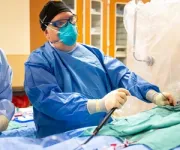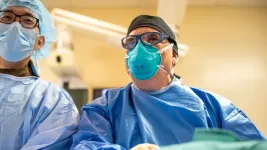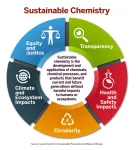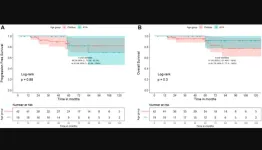(Press-News.org) Early in the formation of Earth, an ocean of magma covered the planet’s surface and stretched thousands of miles deep into its core. The rate at which that “magma ocean” cooled affected the formation of the distinct layering within the Earth and the chemical makeup of those layers.
Previous research estimated that it took hundreds of million years for that magma ocean to solidify, but new research from Florida State University published in Nature Communications narrows these large uncertainties down to less than just a couple of million years.
“This magma ocean has been an important part of Earth’s history, and this study helps us answer some fundamental questions about the planet,” said Mainak Mookherjee, an associate professor of geology in the Department of Earth, Ocean and Atmospheric Science.
When magma cools, it forms crystals. Where those crystals end up depends on how viscous the magma is and the relative density of the crystals. Crystals that are denser are likely to sink and thus change the composition of the remaining magma. The rate at which magma solidifies depends on how viscous it is. Less viscous magma will lead to faster cooling, whereas a magma ocean with thicker consistency will take a longer time to cool.
Like this research, previous studies have used fundamental principles of physics and chemistry to simulate the high pressures and temperatures in the Earth’s deep interior. Scientists also use experiments to simulate these extreme conditions. But these experiments are limited to lower pressures, which exist at shallower depths within the Earth. They don’t fully capture the scenario that existed in the planet’s early history, where the magma ocean extended to depths where pressure is likely to be three times higher than what experiments can reproduce.
To overcome those limitations, Mookherjee and collaborators ran their simulation for up to six months in the high-performance computing facility at FSU as well as at a National Science Foundation computing facility. This eliminated much of the statistical uncertainties in previous work.
“Earth is a big planet, so at depth, pressure is likely to be very high,” said Suraj Bajgain, a former post-doctoral researcher at FSU who is now a visiting assistant professor at Lake Superior State University. “Even if we know the viscosity of magma at the surface, that doesn’t tell us the viscosity hundreds of kilometers below it. Finding that is very challenging.”
The research also helps explain the chemical diversity found within the Earth’s lower mantle. Samples of lava — the name for magma after it breaks through the surface of the Earth — from ridges at the bottom of the ocean floor and volcanic islands like Hawaii and Iceland crystallize into basaltic rock with similar appearances but distinct chemical compositions, a situation that has long perplexed Earth scientists.
“Why do they have distinct chemistry or chemical signals?” Mookherjee said. “Since the magma originates from underneath the Earth’s surface, that means the source of the magma there has chemical diversity. How did that chemical diversity begin in the first place, and how has it survived over geological time?”
The starting point of chemical diversity in the mantle can be successfully explained by a magma ocean in the Earth’s early history with low viscosity. Less viscous magma led to the rapid separation of the crystals suspended within it, a process often referred to as fractional crystallization. That created a mix of different chemistry within the magma, rather than a uniform composition.
Doctoral student Aaron Wolfgang Ashley from FSU as well as Dipta Ghosh and Bijaya Karki from the Department of Geology and Geophysics at Louisiana State University were co-authors of this paper.
This work was funded by the National Science Foundation.
END
Mysteries of the Earth: FSU researchers predict how fast ancient magma ocean solidified
2023-02-27
ELSE PRESS RELEASES FROM THIS DATE:
The Texas Heart Institute delivers a new first in heart failure treatment using cell therapy
2023-02-27
Houston, TX – February 27, 2023 – Physician-scientists at The Texas Heart Institute announced today the results of the largest cell therapy trial to date in patients with chronic heart failure due to low ejection fraction. The therapy benefited patients by improving the heart’s pumping ability, as measured by ejection fraction, and reducing the risk of heart attack or stroke, especially in patients who have high levels of inflammation. Also, a strong signal was found in the reduction of cardiovascular death in patients treated with cells. The findings ...
Augmented reality headset enables users to see hidden objects
2023-02-27
MIT researchers have built an augmented reality headset that gives the wearer X-ray vision.
The headset combines computer vision and wireless perception to automatically locate a specific item that is hidden from view, perhaps inside a box or under a pile, and then guide the user to retrieve it.
The system utilizes radio frequency (RF) signals, which can pass through common materials like cardboard boxes, plastic containers, or wooden dividers, to find hidden items that have been labeled with RFID tags, which reflect ...
How common is face blindness?
2023-02-27
How Common Is Face Blindness?
Study suggests condition affects more people than previously thought
For Immediate Release
Media Contacts:
Dennis Nealon
Dennis_Nealon@hms.harvard.edu
508-494-6117
Ekaterina Pesheva
Ekaterina_Pesheva@hms.harvard.edu
617-432-0441
At a Glance:
Study by researchers at Harvard Medical School/VA Boston Healthcare System suggests that face blindness lies on a continuum and may be more common than currently believed.
The study found similar face matching performance between prosopagnosics diagnosed with stricter vs. looser criteria, suggesting that the diagnostic criteria should be expanded.
As many as ...
Midwifery care safe for moderate- and high-risk pregnancies
2023-02-27
New UBC research shows that midwives in British Columbia are providing safe primary care for pregnancies of all medical risk levels, contrary to a popular belief that midwives mostly manage low-risk pregnancies.
The study, published in the Canadian Medical Association Journal, examined a decade of births in B.C. between 2008 and 2018. The researchers compared birth outcomes for people who had a midwife as their most responsible provider (MRP), with those who were cared for by a family physician or obstetrician.
The findings reveal that people who had a ...
Sustainable chemistry experts create blueprint for safer future
2023-02-27
Feb. 27, 2023
Media contacts:
Emily Gowdey-Backus, director of media relations, Emily_GowdeyBackus@uml.edu
Nancy Cicco, assistant director of media relations, Nancy_Cicco@uml.edu
Sustainable chemistry experts create blueprint for safer future
Group to share its work during free UMass Lowell webinar on March 1
Toxic chemicals – which pop up in everything from household cleaners and appliances to medical devices, paints, packaging and more – are all around. The February ...
Early-life stress can disrupt maturation of brain’s reward circuits, promoting disorders
2023-02-27
Irvine, Calif., Feb. 27, 2023 — A new brain connection discovered by University of California, Irvine researchers can explain how early-life stress and adversity trigger disrupted operation of the brain’s reward circuit, offering a new therapeutic target for treating mental illness. Impaired function of this circuit is thought to underlie several major disorders, such as depression, substance abuse and excessive risk-taking.
In an article recently published online in Nature Communications, Dr. Tallie Z. Baram, senior author and UCI Donald Bren Professor and Distinguished Professor in the Departments of Anatomy & Neurobiology, ...
Cedars-Sinai’s efforts to combat lower back pain get $2 million boost from CIRM
2023-02-27
Investigators at Cedars-Sinai have received a $2 million grant from the California Institute for Regenerative Medicine (CIRM) to develop a new cell therapy that helps improve quality of life for patients with degenerated discs and chronic lower back pain.
Dmitriy Sheyn, PhD, assistant professor in the departments of Orthopaedics, Surgery and Biomedical Sciences at Cedars-Sinai leads this new project in collaboration with Debiao Li, PhD, director of the Biomedical Imaging Research Institute and professor of Biomedical Sciences and Imaging at Cedars-Sinai; and Hyun Bae, MD, professor of Orthopaedics and co-medical ...
Amazon develops algorithm to improve collaboration between robots and humans
2023-02-27
New Study Key Takeaways:
A new algorithm is identified to allow robots and humans to work together efficiently and profitably.
Robots bring shelves of inventory to associates to pick for customer orders.
The adoption of the algorithm cuts down on distance traveled by pods as well as the storage footprint for the company.
The fulfillment operation with the new algorithm results in a half a billion dollars in savings.
BALTIMORE, MD, February 27, 2023 – Amazon has identified a financially beneficial way for robots and humans to coexist, and it’s saving the online enterprise half a billion dollars per year. Using robots to bring ...
Oncotarget | WNT-pathway medulloblastoma: What constitutes low-risk and how low can one go?
2023-02-27
“The definition of low-risk WNT-pathway medulloblastoma may need to be refined in light of recent clinical data and newer biological information.”
BUFFALO, NY- February 27, 2023 – A new research perspective was published in Oncotarget's Volume 14 on February 7, 2023, entitled, “WNT-pathway medulloblastoma: what constitutes low-risk and how low can one go?”
Novel biological insights have established that medulloblastoma is a heterogenous disease comprising four broad molecular subgroups - WNT, SHH, Group 3, and Group 4 respectively, resulting in the incorporation of molecular/genetic information in 5th edition ...
Rutgers researchers use artificial intelligence to predict cardiovascular disease
2023-02-27
Researchers may be able to predict cardiovascular disease – such as arterial fibrillation and heart failure – in patients by using artificial intelligence (AI) to examine the genes in their DNA, according to a new Rutgers study.
“With the successful execution of our model, we predicted the association of highly significant cardiovascular disease genes tied to demographic variables like race, gender and age.” said Zeeshan Ahmed, a core faculty member at the Rutgers Institute for Health, Health Care Policy and Aging ...






